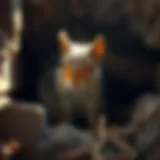Effective Strategies to Eliminate Rat Holes in Your Yard
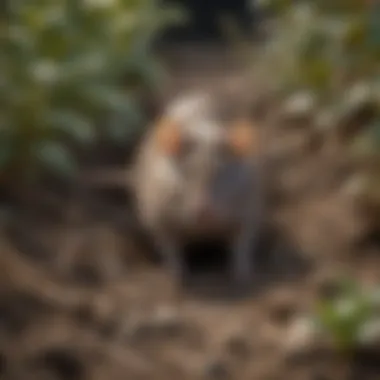

Intro
Addressing rat holes in your yard can feel like a never-ending battle for homeowners. Those pesky creatures can undermine not just the aesthetics of a garden but also its structural integrity. Gaining insight into rodent behavior and implementing effective strategies can help maintain a safe and pleasing outdoor environment. This article aims to provide a comprehensive guide tailored to housewives and house owners on how to tackle these unwelcome squatters through prevention, eco-friendly solutions, and long-term management.
Understanding Pests
Definition of Pests
Pests are generally defined as organisms that cause harm to humans, their interests, or the environment. Among these, rodents like rats have made a name for themselves as common yet troublesome visitors. They often invade residential spaces, looking for food and shelter. Gaining an understanding of these creatures, including their behavior and habits, is crucial for any effective pest management strategy.
Importance of Pest Identification
Before embarking on a mission to eradicate rat holes, it's important to identify not just the presence of rodents but also the specific type that's causing trouble. Different species may necessitate distinct approaches for control. Paying attention to telltale signs, such as droppings, gnaw marks, or signs of nesting, can go a long way. Identifying these signs can help tailor the prevention or removal strategy effectively, rather than playing a guessing game as many do.
Prevention Techniques
Home and Garden Preventative Measures
Preventing rats from taking up residence is often more effective than trying to remove them later. Here are several strategies:
- Seal Entry Points: Make sure holes and gaps around pipes, foundations, and doors are sealed. Rats can squeeze through surprisingly small openings.
- Keep Food Secure: Avoid leaving pet food outside or unsecured trash. Store food in airtight containers and make sure your compost pile is also secure.
- Implement Cleanliness: Regularly clean up spills and crumbs in both indoor and outdoor spaces. Rodents are scavengers, so removing their food source will deter them.
Seasonal Prevention Tips
Understanding the seasons can help you anticipate times when rodents might be more active. For instance:
- In spring, as the weather warms, rodents start looking for nesting sites. It’s a good time to check for gaps in your yard.
- In winter, rats may seek shelter and food inside, so proactively check insulation and gaps in your home.
Eco-Friendly Pest Control Solutions
Overview of Sustainable Practices
The shift towards eco-friendly pest control isn't just a trend; it’s a necessity for the health of our environment. Sustainable methods include:
- Utilizing native plants that naturally repel pests.
- Relying on traps rather than chemicals to manage pests.
Natural Remedies and Their Effectiveness
There are numerous natural deterrents one can use:
- Peppermint Oil: Rats generally dislike the strong scent of peppermint. A few drops on cotton balls placed around the yard can deter them.
- Garlic: Garlic is another natural repellent that, when used in concentrated form, can keep rats at bay.
- Soap and Water: A mix of soap and water can be used to create a barrier that rats find unappealing.
It's better to prevent infestations through consistent habits than to wait until they become a major issue.
By bearing in mind the signs of rodent activities and staying vigilant, homeowners can protect their yards effectively while paying homage to sustainability, making their outdoor spaces more inviting as well.
Understanding the Rat Problem
The topic of understanding the rat problem stands as a cornerstone in effectively managing rat holes in your yard. Gaining insight into the behaviors and habits of these pests can drastically enhance your ability to address them before they become a bigger nuisance. This section lays the groundwork for the subsequent methods and strategies detailed later in the article, enriching your overall approach to pest management.
Rats are not just pests but complex creatures with distinct behavioral traits that make them successful survivors. Knowledge of their ways equips homeowners with the tools needed to deter them before they take root. This understanding is not merely about eradication; it’s about creating a harmonious living space where both humans and nature can thrive without the intrusion of disease-carrying rodents.
Behavioral Traits of Rats
Rats are highly social animals and exhibit behaviors that contribute to their rapid reproduction and adaptability. They are primarily nocturnal, which means they do most of their foraging and nesting at night, when most people are not active outdoors. This makes detecting their presence all the more challenging. Here are some notable characteristics regarding their behavior that can inform your strategies:
- Furtive Nature: Rats are cautious and wary creatures. They tend to avoid open spaces, sticking to shadows and tight spaces. This often leads them to construct their burrows near obstacles, bushes, or other hiding spots where they feel secure.
- Hoarding Habits: These critters are meticulous hoarders. They collect food and other materials to store in their nests, which often results in them digging holes into the ground or even under structures like porches and sheds to stash their goods.
- Territorial Behavior: They establish territories and will be understandably defensive of them. If you notice signs of rat activity in your yard, there’s a good chance they are already nesting nearby.
By understanding these behaviors, you can tailor your prevention measures effectively, keeping rats at bay before they set up camp in your yard.
Signs of Rat Infestation
Detecting a rat problem early is imperative to preventing a full-on infestation. Rats can reproduce quickly, and their ability to squeeze into tight spaces means that once they enter your yard, they can become a persistent issue in no time. Look out for the following signs which might indicate an infestation:
- Droppings: Fresh droppings are a telltale sign of active rats. They are usually dark and capsule-shaped, found in areas where food is available or near their burrows.
- Gnaw Marks: Rats gnaw on various materials, including wood, plastic, and wire, to keep their continually growing teeth in check. Inspect areas of your yard for any unusual scratches or bite marks.
- Nesting Materials: Shredded paper, fabric, or dried plant material may indicate nesting sites. If you observe piles of these items, it might be worth investigating further.
- Tracks and Rub Marks: Rats often leave tracks in soft soil or dust. You might also see dark smudge marks along walls from the oils on their fur.
Understanding and recognizing these signs can save you time and effort in managing a potential crisis later.
- Noises: Listen for scratching or squeaking sounds at night, which could indicate their nocturnal activity nearby.
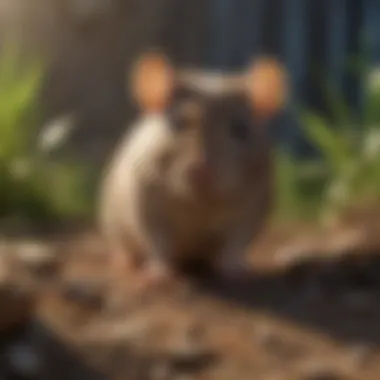

Spotting these signs promptly allows for the implementation of active measures, transforming what could have been a minor issue into manageable control instead of facing a full-scale infestation down the road.
Identifying Rat Holes in Your Yard
Recognizing rat holes in your yard is a crucial part of tackling the rat problem effectively. These holes not only signal a potential infestation but also give insight into the behavior and nesting habits of the rodents. Homeowners who understand where to look and how to assess the situation can often act quickly to prevent an escalation, thus safeguarding their property and peace of mind.
Common Locations for Rat Holes
Rats aren't picky about where they choose to make themselves at home. When scouring your yard, there are a few key areas where you’re likely to find rat holes.
- Near structural foundations: Rats commonly burrow next to the foundations of homes, sheds, or other structures. A small crack can be an invitation to enter and create a nest.
- In gardens or shrubbery: Dense foliage provides excellent cover for rats. They love to dig and can create holes in flower beds or under bushes.
- Around trash bins: If you haven’t secured your garbage, it becomes a buffet for these critters. Look around the perimeter of your waste disposal areas; holes here might suggest that rats are using these spots as access routes.
- In crawl spaces and basements: Rats can wiggle through really tiny openings. If they find a way to get inside, they often create a tunnel down there.
Identifying these locations early on can help you take preventive measures before things get out of hand. Remember to inspect these areas regularly, especially after periods of heavy rain or changes in temperature.
Measuring the Impact of Rat Holes
Understanding the impact of rat holes on your property can be a game-changer in your efforts to manage them. Not only can these holes cause damage to structures, but they may also present health concerns. Here’s how to gauge the severity:
- Structural damage: Observe if your foundational walls have any cracks or loosening. Rat burrowing can undermine the integrity of your property.
- Agricultural concerns: If you maintain a garden, assess for plant damage. Rats can uproot seedlings or munch on vegetables, which no gardener appreciates.
- Health risks: Rats can carry diseases which may affect you and your family. If you spot holes, consider the potential of exposure to harmful pathogens.
- Behavioral indicators: Keep an eye on the frequency of rat activity. If you notice new holes appearing consistently, that signals a more significant problem that needs immediate attention.
"By recognizing the signs early, potential damage and health risks can be minimized. Regular inspections will certainly pay off in the long run."
In summary, identifying rat holes can not only save your yard from becoming a rat haven but also protect your home and your family from the repercussions that come with infestations. The insights gained through these observations help in crafting a thorough pest management strategy.
Methods for Eliminating Rat Holes
Addressing rat holes in your yard is crucial for several reasons. Not only do these burrows pose a threat to the structural integrity of your property, but they also enable the spread of diseases and attract other pests. Effectively dealing with them ensures a healthier environment for your family and enhances your yard's overall appearance. This section will discuss practical methods that homeowners can implement to mitigate and eliminate rat holes, focusing on their effectiveness and minimal ecological impact.
Physical Barriers and Exclusions
Creating physical barriers can be one of the most effective strategies in the battle against rats. The goal is to prevent these persistent rodents from re-entering or establishing new burrows. Start by examining your yard carefully to identify potential entry points; gaps in fences, cracks in foundations, or even spaces under doors should be thoroughly inspected.
Here are some effective methods to address these vulnerabilities:
- Secure Fencing: Install mesh wire fencing, ideally buried a few inches underground, to stop rats from digging underneath. Ensure that the mesh has holes no larger than 1 inch.
- Closing Gaps: Use materials like steel wool or caulking to fill in gaps where pipes enter the ground. This can effectively block access to rats looking for warmth and shelter.
- Capping Openings: Ventilation holes and other openings should be sealed with metal caps or non-chewable materials. This will ensure that rats cannot find a new cozy spot in your yard.
Remember, while these strategies can be effective when implemented properly, ongoing vigilance is required. Regularly make inspections a habit to catch any new developments early.
Natural Deterrents
Natural deterrents can complement your defense against rat invasion, utilizing substances that rats find unpleasant without resorting to harmful chemicals. Evaluating the following items in your pest control strategy could be significant:
- Peppermint Oil: This oil is often touted as a natural rat repellent. Soak cotton balls in peppermint oil and place them strategically around areas affected by rats. The strong scent can discourage them from frequenting those spots.
- Castor Oil: Known for its unappealing odor, castor oil can be effective when mixed with water and sprayed around your property. It's a simple homemade solution that can work wonders.
- Concrete and Gravel: Not only can concrete paths prevent rats from digging, but a layer of gravel can also serve as an uncomfortable surface for them to navigate. This subtle change to your landscaping may deter them from settling down.
While these natural deterrents can help, combining them with a more aggressive strategy (like physical barriers) often yields better results.
Trapping Techniques
If you find that rats have already made themselves at home in your yard, trapping is often a necessary step. Traps enable you to capture these rodents effectively without resorting to poisons that may affect pets or other wildlife. Here’s how to optimize your trapping efforts:
- Choosing the Right Trap: Snap traps are often the most effective for rat control. Opt for larger traps that can handle their size, as smaller traps may go ignored. Additionally, consider humane traps to catch and release without harming the animals.
- Setting Up the Traps: Place traps near suspected rat activity, often close to burrows or along the paths they frequent. Use catchy bait like peanut butter or dried fruit to draw them in.
- Monitor Regularly: Frequent checks on traps will help you identify when they are triggered. Disposing of captured rats promptly and safely is critical to controlling the population.
Utilizing trapping techniques requires some persistence and patience. It’s essential to keep the area surrounding the traps clear to enhance their effectiveness.
Eco-Friendly Solutions for Pest Control
This section underscores the importance of adopting eco-friendly solutions for pest control, particularly when tackling the ongoing nuisance of rat holes in your yard. As residential areas grow and green spaces become more inviting for both humans and animals, the delicate balance between pest management and environmental integrity becomes crucial. With increasing awareness about chemical pesticides and their potential hazards, homeowners are leaning towards alternative methods. Not only do these solutions minimize harm to local ecosystems, but they also promote healthier surroundings for families and pets.
Adopting an eco-friendly approach can lead to multiple benefits:
- Safety: Non-toxic strategies ensure a safer living environment, especially for children and pets.
- Sustainability: These solutions often focus on long-term prevention rather than short-term fixes.
- Cost-Effectiveness: Natural methods can sometimes be more economical than harsh chemicals.
Encouraging sustainable practices creates an awareness that can be shared within communities, fostering a collective approach to pest management. This method aligns both with the immediate goal of dealing with rat infestations and the broader objective of preserving biodiversity in our local ecosystems.
Utilizing Non-Toxic Baits
One effective method of controlling rats without the use of hazardous chemicals is through non-toxic baits. These baits should be selected for their ingredients, ensuring that they are safe for not only rodents but also for other wildlife and pets. Common non-toxic ingredients include:
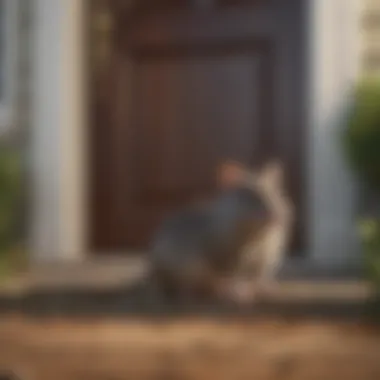

- Peanut butter: Its strong scent appeals to rats and allows for easy application on traps.
- Oatmeal: A simple food source that can be used in baits and traps.
- Vegetable oil: This can be mixed with other food ingredients to create a more potent bait.
When setting the traps, it’s essential to place them in areas where you’ve observed rat activity, typically near the holes or pathways. Check these traps regularly to remove any trapped pests promptly, keeping the area clean to prevent attracting other rodents or wildlife. Using non-toxic baits not only addresses the immediate issue but also builds a foundation for a more sustainable pest management strategy.
"In the world of pest control, sustainability and safety can walk hand in hand without causing a ruckus."
Implementing Habitat Modification
Another vital strategy in controlling rat populations involves habitat modification. This approach seeks to eliminate the conditions that are favorable for rat habitation in your yard. By adjusting the environment, you create a less inviting space that can actively deter these rodents. Consider the following changes:
- Remove Food Sources: Secure garbage bins with tight-fitting lids, compost food waste wisely, and regularly clean up pet food from the yard.
- Trim Vegetation: Overgrown bushes and tall grass provide cover for rats. Keeping your landscaping tidy can help deter them from taking up residence.
- Seal Off Shelter Spots: Inspect your home and yard for potential nesting areas, such as debris piles, under decks, or spaces between structures. Filling in cracks and ensuring proper drainage can help eliminate the safe havens that rats seek.
Modifying the habitat also cultivates an awareness within your household. Involving family members in keeping the yard clean and maintaining these changes ensures that everyone understands their role in pest management. Homeowners who adopt these practices may very well notice not only a decline in rat activity but also a healthier yard overall.
Long-Term Yard Management Strategies
Long-term yard management strategies play a crucial role in preventing rat infestations and maintaining a healthy outdoor space. Not only do these strategies aim to eliminate existing problems, but they also emphasize a proactive approach to avoid future rat holes from emerging. By integrating these methods into your regular gardening and yard maintenance routine, you can create an environment that discourages rodents from taking up residence.
The benefits of implementing long-term management strategies are numerous. Firstly, regular inspections and maintenance of your yard can identify potential issues before they escalate. This early detection can save time, money, and effort down the road. Secondly, creating a less inviting environment for rats directly contributes to pest control efforts. When rats find it uncomfortable or unsafe in your yard, they are more likely to seek shelter elsewhere.
Moreover, these strategies foster a sustainable living approach, making your yard a more pleasant and safe space for you and your family and ensuring that any pest control methods used are respectful of local wildlife and biodiversity.
Regular Inspections and Maintenance
One essential part of any long-term yard management plan is the ongoing practice of regular inspections and maintenance. This process should not just be a seasonal chore, but rather an ongoing habit. Every now and then, set aside time to carefully survey your yard.
During these inspections, pay attention to signs that might indicate the presence of rats or other pests. Look for any unusual holes in the ground, droppings, or even chew marks on any plants. Performing such checks can allow you to act swiftly if you notice anything amiss.
Besides identifying potential rat issues, maintenance of your yard involves keeping the environment tidy. Mow the lawn regularly, remove debris, and keep trash in sealed containers. Ensuring that your outdoor space is clean makes it less appealing to rats looking for food and shelter. Here are some key elements to consider for effective inspections:
- Visual Checks: Look for holes or nests that could signify a rat presence.
- Sanitation: Remove food sources by keeping pet food indoors and cleaning up fallen fruits or vegetables from yards.
- General Maintenance: Seal off potential entry points such as gaps around fences or under decks.
"An ounce of prevention is worth a pound of cure." —Benjamin Franklin
Creating a Less Inviting Environment for Rats
Creating an environment that discourages rats is not just about active measures; it is also about passive strategies that make your yard less appealing to rodents. Make it clear that your yard is not their ideal habitat.
Start by managing food sources. This can be as simple as properly storing birdseed, clearing away pet food left outdoors, and cleaning up any compost areas that might be attracting vermin. A good rule of thumb is to minimize any clutter or material that could be used as nesting sites.
Next, consider landscaping choices. Dense shrubs and tall grass may provide cover for rats, allowing them easy access to shelter. By trimming back overgrown vegetation and opting for less dense planting, you enhance visibility, making it less attractive for rats to hide.
Here are some strategies to consider:
- Use plants that deter rodents: Certain herbs and flowers like mint or marigold can act as natural deterrents to pests.
- Install fencing: A barrier can help keep pests from taking up residence. Ensure the fence is buried a foot underground to deter digging.
- Limit water sources: Ensure there are no standing water areas and fix leaks immediately.
By consistently applying these management strategies, you can effectively contribute to a healthy yard and drive rats away, ensuring that your property remains a sanctuary rather than a hotspot for unwanted pests.
When to Seek Professional Help
Dealing with a rat problem in your yard can be a daunting task. While many homeowners aim to tackle the issue on their own, there comes a time when seeking professional help becomes essential. Understanding when to call for reinforcements can make the difference between a minor inconvenience and a full-blown infestation.
Recognizing the Severity of Infestation
It’s critical to gauge the severity of your rat situation before deciding to go solo or to hire a pro. Here are some signs that might indicate you’re facing more than just an isolated occurrence:
- Frequent Sightings: Spotting multiple rats during the day suggests a larger problem. Rats are nocturnal, so seeing them out in the open usually signals they’re comfortable, meaning there might be a sizeable infestation.
- Nesting Materials: Discovering shredded materials like paper, fabric, or insulation is a red flag. If you find nests in your yard or close proximity to your home, it’s a good idea to seek out a pest control service.
- Damage to Property: If you notice gnaw marks on wood, wires, or even your garden’s vegetation, your yard has become a rat haven. Damage can escalate quickly, leading to higher repair costs.
- Increased Droppings: More droppings than usual, especially near identified holes, signifies an active population.
On a related note, if you're beginning to smell something foul or suspect a dead rat is nearby, it's time to give professionals a call. They know how to handle dead animals safely and can address any potential health risks associated with rodent infestations.
Choosing the Right Pest Control Service
When the decision to hire a pest control service arises, picking the right company can feel as perplexing as choosing what to watch on Netflix. Here are considerations to simplify your selection process:
- Reputation and Reviews: Look for companies that have solid recommendations. Do some digging online; check platforms like Reddit and specialized forums. Word of mouth, especially from people in your community, can be invaluable.
- Experience with Rodent Control: Different companies specialize in various pests. Ensure that the service you choose has a proven track record with rats. Ask them about their successes and techniques.
- Eco-Friendly Options: If you prefer sustainable solutions or have pets and children, confirm if they offer non-toxic methods. More companies nowadays are adopting eco-conscious tactics in pest management.
- Licensing and Certification: In the pest control industry, credentials are paramount. Confirm that the company is licensed to operate in your area. This ensures that they abide by local regulations and industry standards.
- Comprehensive Services: It's advantageous to opt for a service that provides both treatment and prevention tactics. This way, you can tackle the current issue and minimize the chances of future infestations.
- Post Service Follow-Up: You want a service that does not just set traps and run. The best pest control services will offer follow-up consultations and checks to assess progress.
Ultimately, taking action early and being aware of the signs can greatly alter the course of managing rats in your yard. If the problem escalates beyond your control, don’t hesitate to reach out for professional assistance. After all, a peaceful, rodent-free yard is something every homeowner deserves.
The Role of Community in Pest Management
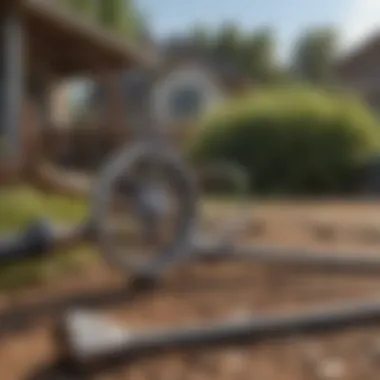

Managing rat populations in residential areas often transcends individual efforts; it requires a collaborative approach. The effectiveness of pest management strategies can significantly improve when communities work together. By sharing knowledge and resources, neighborhoods can take a proactive stance against rats, making their environment less hospitable to these pests. This section underscores the essential role individuals and local groups play in creating a rat-free community.
Collective Efforts in Rat Control
A concerted effort among community members can lead to more successful rat control. When families and neighbors join forces, they can tackle common issues more efficiently. Here are several ways collective action can strengthen pest management:
- Organized Clean-ups: Hosting community clean-up events helps eliminate food sources and potential nesting materials that attract rats. Such gatherings not only beautify the neighborhood but also promote a sense of belonging.
- Shared Resources: Local groups can pool their resources to acquire traps, poison, or barriers. This collective investment can also include hiring a pest control expert to provide consultations.
- Neighborhood Watch Programs: Creating a rat watch initiative, similar to neighborhood watch schemes, encourages residents to report sightings and track infestations. This information can help in strategizing focused interventions.
"An ounce of prevention is worth a pound of cure." This age-old adage holds particularly true in managing pests like rats.
By taking these collective approaches, communities may find that tackling rat problems becomes less daunting and more manageable.
Education and Public Awareness Initiatives
Educating the community about rat management is crucial in preventing infestations. Awareness initiatives can significantly shift public perception and behavior towards pest control. Here are a few effective strategies:
- Workshops and Seminars: Local governments or community organizations can host workshops that educate residents about identifying rat signs and implementing preventive measures. Engaging speakers who can share firsthand experiences will enrich these sessions.
- Pamphlets and Flyers: Distributing educational materials can keep the community informed. These resources should outline the signs of infestation, effective control methods, and tips for maintaining a rat-free yard.
- Digital Campaigns: Utilizing platforms like Facebook or community forums on Reddit to spread awareness can engage a larger audience. Posts that share success stories from local residents can motivate more individuals to participate in pest management efforts.
Encouraging dialogue and sharing information builds a knowledgeable community that can collectively navigate rat control challenges.
In summary, fostering community efforts and education equips neighborhoods to effectively combat rat problems. A united front not only deters rat populations but also strengthens the bonds between community members, promoting a healthier environment for everyone.
Understanding the Ecological Impact
When dealing with rat holes in your yard, one must not overlook the broader ecological implications of these pests. It's essential to grasp how the presence of rats can affect local ecosystems. Rats, often seen as mere nuisances in to homes, can actually disrupt the delicate balance of wildlife and plant life in your backyard.
Impact of Rats on Local Ecosystems
Rats have a tendency to invade and disrupt various environments, leading to a cascade of ecological effects. Their remarkable adaptability allows them to thrive in diverse habitats. They compete with native species for food resources, may prey on bird eggs and small mammals, and can lead to the decline of local wildlife populations. An unchecked population of rats can cause a significant imbalance, impacting not only the flora and fauna but also the soil quality and overall health of your yard.
Some of the specific ways rats can affect local ecosystems include:
- Predation Pressure: They prey on bird eggs and nestlings, significantly lowering populations of native birds.
- Competition for Resources: Rats will target the same food sources as other wildlife, starving smaller animals.
- Disease Reservoir: Rats can carry various diseases, which can transmit to pets and even humans. This poses a health risk that extends beyond gardens into neighborhoods.
With this understanding, one might see that addressing rat holes isn't just a matter of personal comfort but also a responsibility toward preserving local ecosystems.
Balancing Pest Control with Biodiversity
That being said, it's also crucial to maintain a balance between effective pest control and the preservation of biodiversity. When attempting to remove rats, one must be mindful that certain control methods can inadvertently affect other wildlife positively. For example, employing pesticides can kill not only the pests but also beneficial insects and even small mammals that play important roles in the ecosystem.
To maintain this balance, consider the following strategies:
- Utilize Targeted Traps: Instead of broad-spectrum poisons, opt for traps that specifically target rats without posing a threat to other wildlife.
- Natural Deterrents: Employing natural repellents, such as peppermint oil or predator urine, can help dissuade rats without harming beneficial animals.
- Habitat Enhancement: By enhancing the environments of native species, you can encourage them to thrive despite the presence of rats, which can keep the rat population in check naturally.
Ultimately, a thoughtful approach not only addresses the immediate issue of rat holes but also safeguards the local biodiversity, creating a healthier garden environment for everyone.
"The health of local ecosystems depends on the complex interrelations among species; understanding these can enhance our pest management strategies."
By weighing these ecological aspects, homeowners can create more effective, sustainable practices in managing not just the rat problem but fostering a harmonious relationship with nature.
Resources for Further Learning
When it comes to tackling the rat problem in your yard, knowledge is your best ally. Having accessible resources to guide you is crucial not only for the immediate issues but also for long-term management. Understanding the strategies used for pest control can empower homeowners to take proactive measures for a healthier yard environment. As you delve deeper into tackling rat holes, various learning resources can provide reliable information and support. They can reveal nuances about pest behavior that might otherwise go unnoticed.
Books on Pest Management
Books offer a wealth of structured information, combining theoretical knowledge with practical applications. Reading detailed texts can enhance your understanding of rat behaviors, effective control measures, and environmental considerations. A few recommended titles include:
- Rodent Control: A Practical Guide by R. W. Cappuccino – This book dives into both physiological insights and ecological impacts, ensuring you know how to manage rat populations effectively while meantaining a balance in your yard’s ecosystem.
- The Encyclopedia of Pest Management by David Pimentel – Including sections on various pests, you will find a branch dedicated to rodents. It's an essential read for anyone serious about pest control, breaking down strategies and the science behind them.
- Urban Pest Management by G. R. W. Smith – Focused on urban dwellings, this book discusses invasion routes, natural deterrents and how to integrate sustainable practices into pest management solutions.
Books like these are especially beneficial for housewives and homeowners who prefer to explore topics in depth at their own pace. They can also serve as reference guides when tackling specific issues in your yard.
Online Guides and Community Forums
In addition to printed materials, the internet offers a slew of resources that can be instantly accessed. Online guides often provide up-to-date insights into pest management techniques that are currently trending or scientifically validated. Some notable platforms include:
- Wikipedia (en.wikipedia.org) – Here, you will find articles covering various topics related to pest management, including behavior, prevention, and control methods regarding rats. The entries are regularly updated, ensuring that the information is fresh and relevant.
- Britannica (britannica.com) – An excellent resource for well-researched articles. It provides historical context as well as data that could be crucial in understanding why certain pest management strategies are used today.
- Reddit (reddit.com) – Particularly useful for real-world advice and experiences. Community threads on platforms like Reddit bring together homeowners who share their trials and errors, offering a rich tapestry of knowledge regarding the nuances of pest control.
Utilizing community forums helps foster a sense of camaraderie among homeowners. It allows for a sharing of tips, and tricks, and moral support, which can be invaluable when dealing with a persistent rodent problem.
In summary, whether you prefer the solidity of books or the dynamic nature of online resources, leveraging a variety of learning tools will help you stay a step ahead of any rat-related issues in your yard. The right knowledge not only prepares you for tackling current problems but also arms you with the skills to prevent future occurrences.
"An ounce of prevention is worth a pound of cure." – Benjamin Franklin
Invest your time in these resources, and you'll gain the confidence and know-how to manage your yard effectively.
